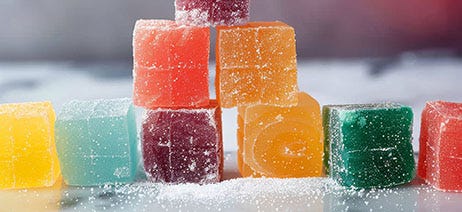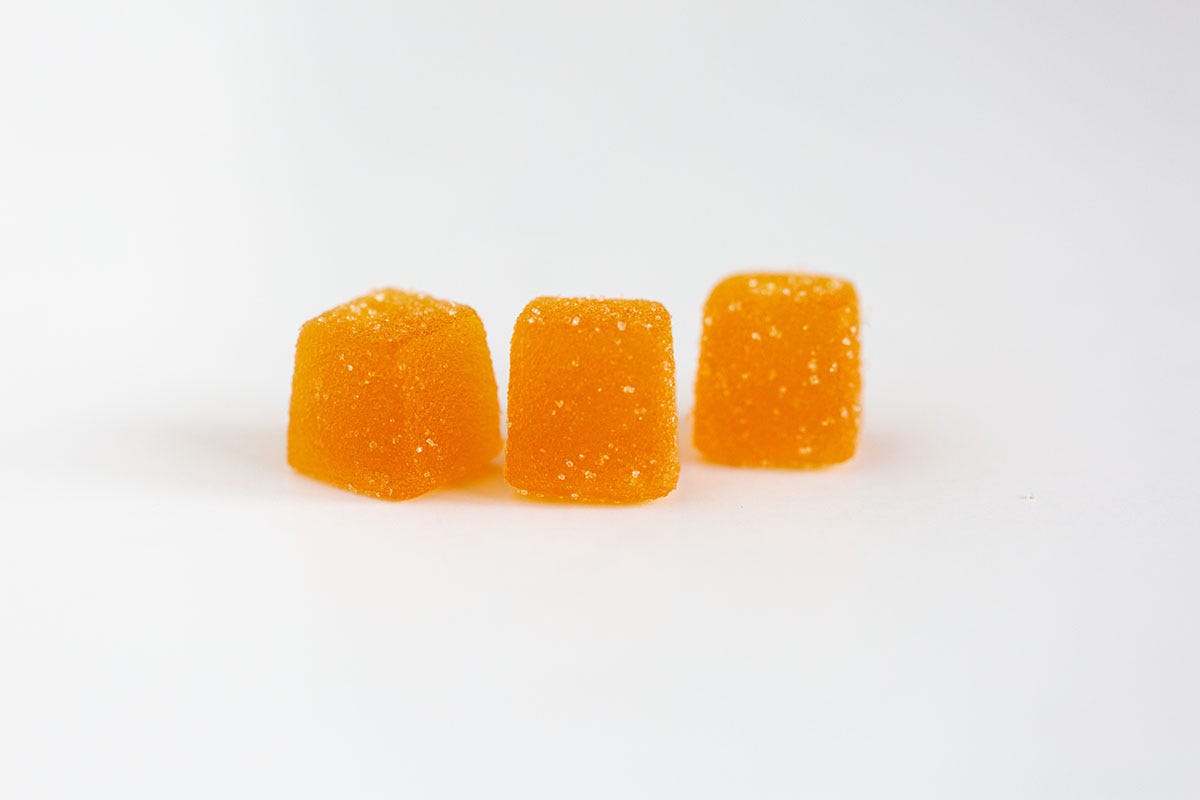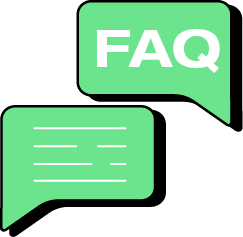
What Are Marijuana Gummies?
Imagine sinking your teeth into a sweet, chewy treat that offers more than just a sugar rush. Deliciously discreet, THC gummies offer a flavorful twist on traditional cannabis consumption options. In this guide we will dive into the colorful, delicious world of THC gummies, including details such as:
- What are Marijuana Gummies?
- How Do THC Gummies Work?
- Effects and Benefits of THC Gummies
- Dosing and Consumption
- Safe Storage and Handling
- FAQs About THC Gummies
Types of Marijuana Gummies?
Marijuana edibles are chewable, candy-like edibles infused with cannabinoids derived from the cannabis plant. These dispensary products are available in a range of doses and a variety of flavors – everything from fruity to sour flavors. The majority of edibles you’ll find in a dispensary are made using THC distillate, a concentrated and highly refined liquid form of the desired cannabinoid, as well as other added ingredients like terpenes and various flavoring.1


How Do THC Gummies Work?
When a marijuana gummy is consumed, it heads through the body’s digestive tract, which includes the stomach and the liver. Because there are several steps in digestion, the onset time for any effects is often longer than cannabis that has been smoked or vaped. The process may take as long as 1 hour to start feeling the effects of a gummy, and they may linger for as long as 2-3 hours.1
You may hear from other cannabis consumers that THC gummies have a stronger impact. While there are a variety of factors that affect your experience–including metabolism, tolerance levels, and even how long it’s been since your last meal–the primary reason is due to how the liver metabolizes THC: it converts it into a compound called 11-hydroxy-THC, which is actually more potent.1
Effects and Benefits of THC Gummies
Medical marijuana was first legalized in California as a way to help patients who suffer from a variety of conditions.2 While scientific studies around the medical use of cannabis are limited, we do know that there are potential therapeutic benefits including:
- Increased relaxation3
- Improved sleep4
- Relief from the symptoms of chemotherapy5
Studies have shown that cannabis may help chronic pain sufferers. One study focused on patients with chronic pain who used medical cannabis for pain management, and results revealed that almost 75% of participants reported that cannabis use helped ease their pain.6


Dosing and Consumption
“Start low and go slow.” But what does that mean? Simply put: start with small doses. For example, it’s recommended that you start with a microdose of cannabis–typically 1-2.5 milligrams–and slowly increase your dose once you know how your body will react.
Next, you want to take your time: it can take up to 90 minutes (or more) to feel any effects.8 Beginners may think that nothing is happening and that they should try another gummy or edible, but this is where patience pays off: let your body process THC at its own speed. Wait to see and learn how you respond as everyone’s tolerance is different.


Safe Storage and Handling
Humidity, heat, and sun are like kryptonite to fresh, flavorful THC gummies. Not only can these elements affect the taste, but they can also impact both potency as well as quality of your edibles. To keep your THC gummies fresh and to prevent potency loss, store THC gummies in an air-tight container – glass jars work great – in a dark, climate-controlled location.9


FAQs About THC Gummies
Ready to learn more about THC gummies? Here are some of the frequently asked questions about this popular cannabis edible.
What’s the difference between THC gummies and CBD gummies?
THC gummies contain cannabinoids, which can cause that “high” feeling. CBD gummies may or may not contain THC – be sure to check labels carefully.
How long do THC gummies take to kick in?
It depends. Edibles can take anywhere from 30-60 minutes (or more) to kick in, but the amount of time will vary from person to person, depending on factors such as your metabolism, weight, tolerance, and diet.10
How long do the effects of THC gummies last?
Like the wait for effects to kick in, the duration of time these effects last can vary from person to person. The average duration can last four hours, but as long as 10 hours,11 so you will want to plan your consumption – and schedule – accordingly.
How do I determine the appropriate dosage for THC gummies?
Start low and slow. Microdosing can help you ease into your consumption patterns and learn how your body reacts.
How do I know if I’m getting high-quality and safe THC gummies?
When you visit a state-licensed dispensary, the THC gummies will be from reputable sources that are third-party tested and verified. Your budtender can also provide additional details about each product’s source, brand, and potency.


Exploring THC Gummies
Whether you’re ready to try THC gummies or would like to know more about these cannabis treats, visit your friendly budtender at your local dispensary to find answers to your questions and perhaps even your next favorite THC gummy.
Sources:
1. “Edibles 101: How to consume edibles, benefits, effects, & more,” leafly.com, February 4, 2022, https://www.leafly.com/learn/consume/edibles
2. “Medical Cannabis Guidelines,” State of California Department of Justice, https://oag.ca.gov/medicinal-cannabis
3. “The benefits and risks of weed edibles and how long you’ll be high if you take one,” Business Insider, June 15, 2021, https://www.businessinsider.com/guides/health/how-long-do-edibles-last
4. “Cannabis for Sleep” Sleep Foundation, July 15, 2025, https://www.sleepfoundation.org/sleep-aids/cannabis-and-sleep
5. “How cannabis may ease ‘chemo brain’ and improve sleep for cancer patients,” CU Boulder Today, April 27, 2023, https://www.colorado.edu/today/2023/04/27/how-cannabis-may-ease-chemo-brain-and-improve-sleep-cancer-patients
6. “Chronic Pain Patients’ Perspectives of Medical Cannabis,” National Library of Medicine, July 2017, https://www.ncbi.nlm.nih.gov/pmc/articles/PMC5845915/
7. “The benefits and risks of weed edibles and how long you’ll be high if you take one,” Business Insider, June 15, 2021, https://www.businessinsider.com/guides/health/how-long-do-edibles-last
8. “How To Store Your Edibles,” marijuanapackaging.com, September 14, 2022, https://marijuanapackaging.com/blogs/how-to-guide/how-to-store-your-edibles
9. “How Long Do Edibles Take To Kick In?” healthline.com, https://www.healthline.com/health/how-long-do-edibles-take-to-kick-in
10. “How long will a weed high last?” leafly.com, April 14, 2021, https://www.leafly.com/news/science-tech/how-long-will-a-weed-high-last


